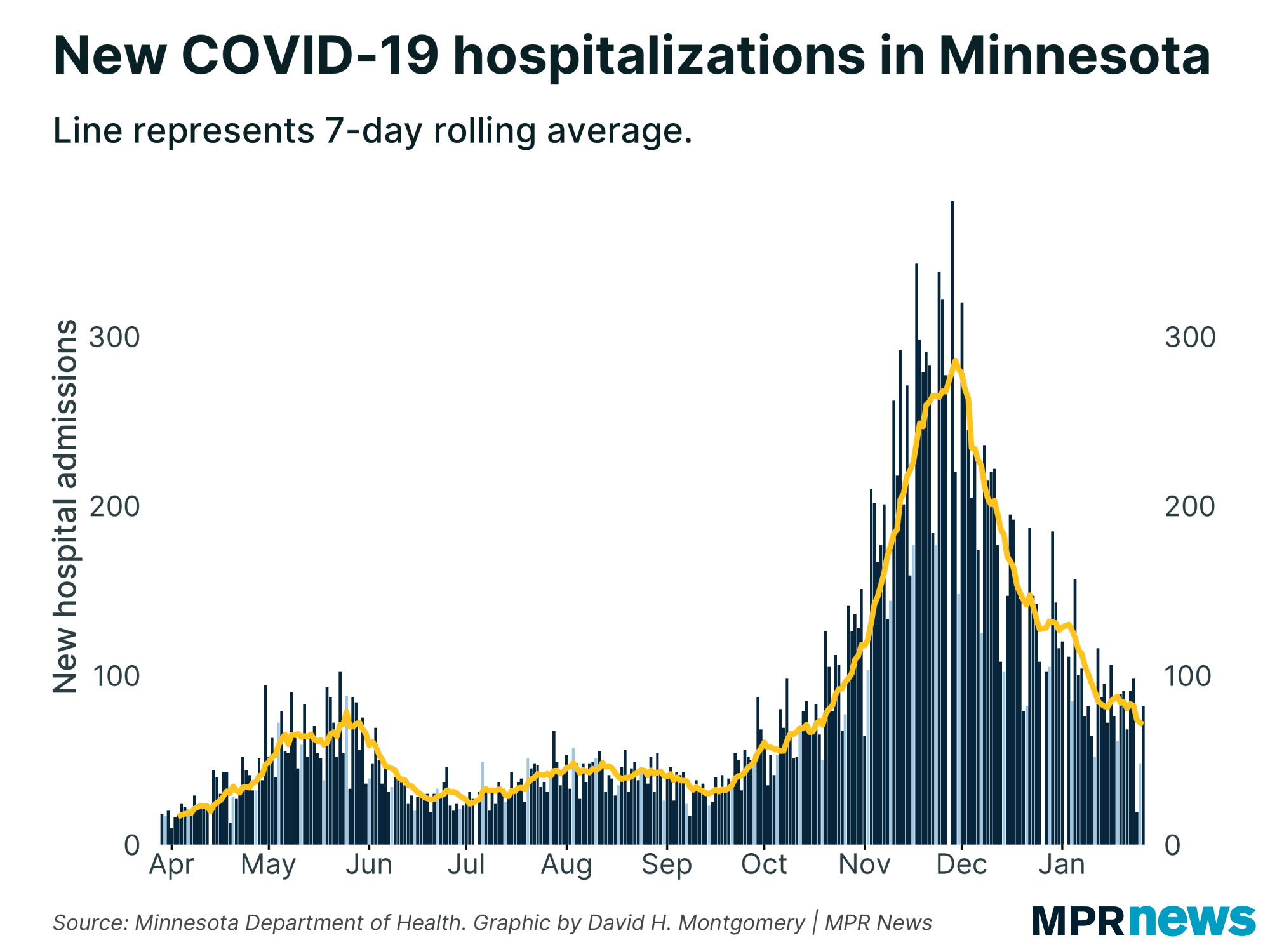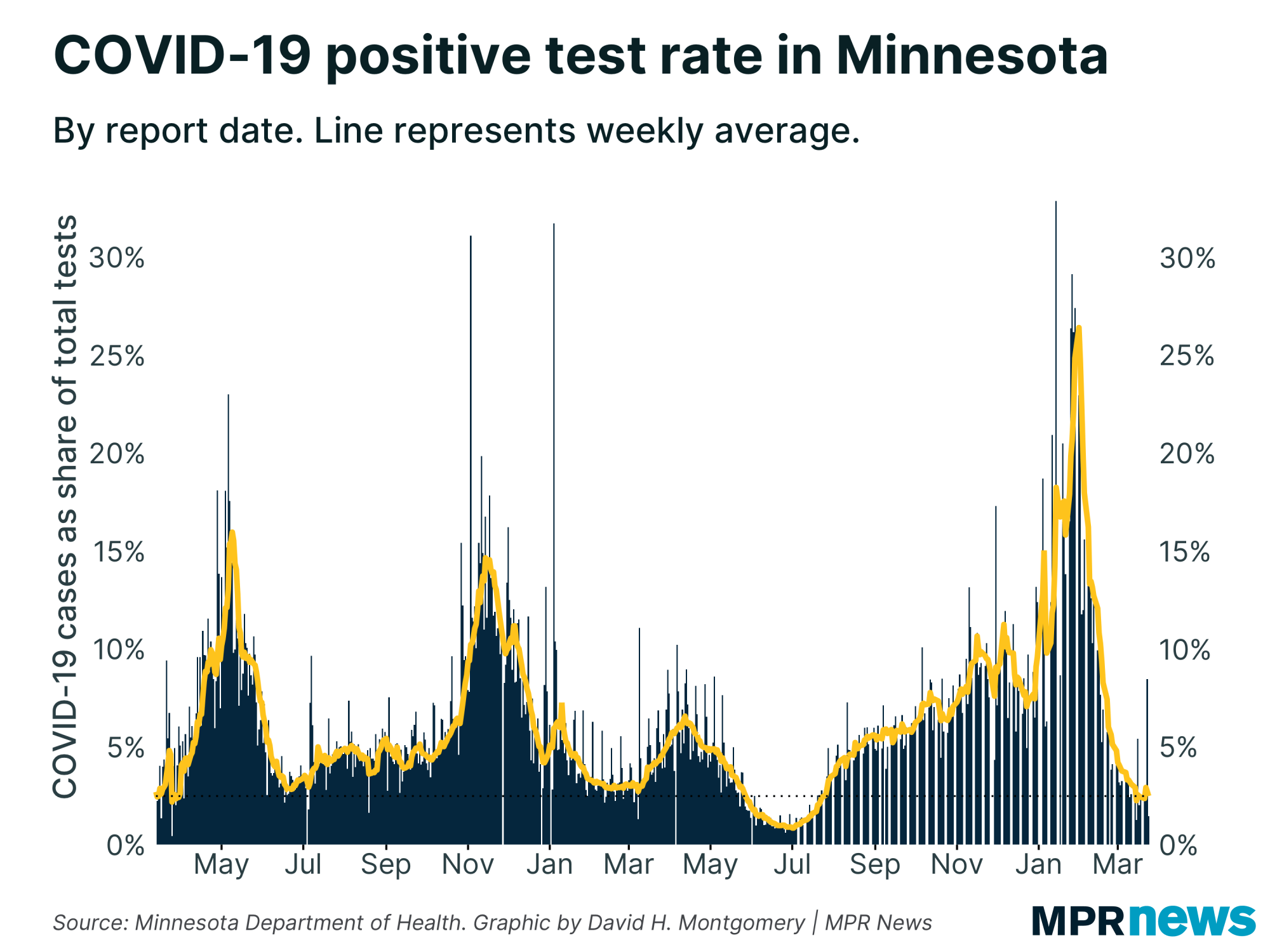Oct. 8 update on COVID-19 in MN: Hospitalizations jump; 8 more deaths

Go Deeper.
Create an account or log in to save stories.
Like this?
Thanks for liking this story! We have added it to a list of your favorite stories.
Updated: 12:05 p.m.
Minnesota officials on Thursday reported the second-highest number of new COVID-19 hospital admissions in a single day in the pandemic, suggesting that some of the recent surge in newly confirmed cases is surfacing now in hospital beds.
Health Department data showed 98 new hospital admissions, the highest total since May. Average hospitalizations are at their highest point since June. There were 22 newly reported intensive care admissions.

Eight more deaths reported Thursday raised Minnesota’s toll to 2,107. Among those who’ve died, about 71 percent had been living in long-term care or assisted living facilities; most had underlying health problems.
Another 1,276 newly confirmed COVID-19 cases reported Thursday brought the total in the pandemic to 107,922 cases to date; about 90 percent have recovered to the point they no longer need to be isolated.
Turn Up Your Support
MPR News helps you turn down the noise and build shared understanding. Turn up your support for this public resource and keep trusted journalism accessible to all.

Separately on Thursday, state officials said they’ve changed their pandemic guidance and are increasing the allowable table/party size in Minnesota restaurants and bars. Updated rules permit as many as 10 people seated together in restaurants and event spaces, up from four or six if they were members of a single household.
The newest COVID-19 numbers follow a stretch of more than a week when average new daily case counts topped 1,000. The trend line of active COVID-19 cases in Minnesota remains at a record high in the pandemic.

Worries continue around college students, kids
New cases are up dramatically since Sept. 1 in all age groups 30 and older.
Still people in their 20s make up the age bracket with the state’s largest number of confirmed cases — some 25,000 since the pandemic began, including more than 14,400 among people ages 20-24.
The numbers help explain why experts remain particularly concerned about young adults as spreaders of the virus.

While less likely to feel the worst effects of the disease and end up hospitalized, experts worry youth and young adults will spread it to grandparents and other vulnerable populations and that spread could hamper attempts to reopen campuses completely to in-person teaching.
The number of high school-age children confirmed with the disease has also grown, with more than 10,200 total cases among children ages 15 to 19 since the pandemic began.

With many schools in Minnesota attempting to teach in-person, officials say they are especially concerned about the rising numbers of teens becoming infected and how that could affect decisions to keep school buildings open.
The Health Department has said seven school buildings in Minnesota have five or more confirmed cases of COVID-19 in students or staff who were in those buildings while infectious during a two-week reporting period.
Surges seen in northern, central Minnesota
Regionally, northern, southern and central Minnesota have driven much of the recent increase in new cases while Hennepin and Ramsey counties show some of the slowest case growth in the state.
Northern Minnesota, once by far the region least affected by the disease, has over the last week averaged the most cases per capita.

Collectively, rural areas of Minnesota continue to report the most new COVID-19 cases.
In southwestern Minnesota, at least 75 cases have been traced to a late-August wedding in Lyon County that officials have previously described as the state’s largest single social spreader event.
Thirty-nine cases have now been traced to a Martin County funeral, with one person hospitalized.
Southeastern Minnesota, specifically Winona, has been another hot spot as students return to college at Winona State and other schools. The problem has been compounded by similar outbreaks nearby across the Mississippi River at the University of Wisconsin-La Crosse.
Deep racial disparities persist
In Minnesota and across the country, COVID-19 has hit communities of color disproportionately hard in both cases and deaths.
Minnesotans of Hispanic descent are testing positive for COVID-19 at about five times the rate of white Minnesotans. They, along with Black Minnesotans, are also being hospitalized and moved to intensive care units at higher rates than the overall population.
Similar trends hold true for Minnesota’s Indigenous and Asian residents.

Distrust of the government, together with deeply rooted health and economic disparities, have hampered efforts to boost testing among communities of color, particularly for undocumented immigrants who fear their personal information may be used to deport them.
Developments around the state
COVID cases leap in Minnesota’s neighboring states
COVID-19 is a topic where Minnesota is perfectly OK not being ranked No. 1. The state has seen its COVID-19 cases grow lately — but this real increase is small compared to other states in the Upper Midwest.
On Sept. 1, Minnesota was reporting around 140 new cases per million residents per day. This week, that figure is up around 185.
Wisconsin was seeing around 130 new cases per million residents per day on Sept. 1, similar to Minnesota. That’s now up to nearly 420 — more than three times higher. The situation has become so concerning that Wisconsin on Wednesday said it would open a field hospital near Milwaukee.
North and South Dakota have similarly seen their cases per capita skyrocket far above Minnesota’s levels.

This is true even though Minnesota has higher testing rates for COVID-19 than every state in the region but North Dakota.
By positivity rate, which controls for testing volume, Minnesota has by far the lowest rate in the Upper Midwest, around 5 percent, versus more than 20 percent for Wisconsin and South Dakota.

Minnesota also has the lowest rates in the region for deaths and COVID-19 hospitalizations, controlling for population size.
— David H. Montgomery | MPR News
Walz set to renew COVID-related powers on Monday
A fifth special session for the year for the Minnesota Legislature has been set for Monday.
Gov. Tim Walz issued the proclamation Wednesday. He’s required by law to call the Legislature into session because he is extending a peacetime emergency related to the coronavirus.
The House and Senate have the power to overturn that authority but it would take majority votes in each chamber, which hasn’t happened to date due to divided party control.
The session will convene at noon on Monday. It’s unclear if other measures, such as a construction projects borrowing bill, will come up for votes.
— Brian Bakst | MPR News
MDH hosting more free testing sites around Minnesota
The Minnesota Department of Health, in partnership with the Minnesota National Guard and local health officials, is offering another round of free COVID-19 testing sites in communities across the state.
"We are doing everything we can to expand access to all Minnesotans for COVID testing," said Dan Huff, assistant commissioner with the state Health Department.
"You don't need an ID," Huff said. "What you do need is a phone number or an email so we can get in touch with you with the results. If you are having any symptoms, definitely go get tested. If you have been identified as a contact of someone who is infected, go get tested. Or if you're anxious — go and get tested."
This week's test sites include:
Cloquet, Fond du Lac Tribal and Community College Gym — Thursday from noon to 6 p.m.
Fairmont, Armory — Thursday from noon to 6 p.m.
Inver Grove Heights, Armory — Thursday from noon to 7 p.m.
Minneapolis, New Salem Baptist Church — Thursday and Friday from 2-6 p.m.
Northfield, Emmaus Church — Thursday from noon to 6 p.m.
St. Joseph, Clemens Field House at College of Saint Benedict — Thursday from noon to 6 p.m.
Willmar, Armory — Thursday from noon to 6 p.m.
State health officials are encouraging people to sign up for an appointment in advance, to avoid long lines. Find more information here.
— MPR News Staff
Top headlines
High School League OKs spectators at indoor events: All schools will be allowed up to a total of two spectators per participant, the Minnesota State High School League said Thursday.
Candidate Jason Lewis self-quarantines for 2nd time in week: Republican U.S. Senate candidate Jason Lewis left the campaign trail for the second time in less than a week Wednesday after learning that he had been in contact with a person who tested positive for the coronavirus.
Wisconsin activates field hospital as COVID-19 keeps surging: Democratic Gov. Tony Evers’ office said in a statement that the facility, at the state fairgrounds near Milwaukee, will open for patients within the next week. Only 16 percent of the state's 11,452 hospital beds were available as of Tuesday afternoon, according to the state Department of Health Services.
Health officials tie northern Minn. COVID-19 surge to everyday gatherings: While the growth of new COVID-19 cases has leveled off in the Twin Cities metro area, it continues to surge in greater Minnesota, especially across the northern third of the state, which over the last week has averaged the most cases per capita.
Wisconsin governor restricts public indoor gatherings: The order limits public indoor gatherings to 25 percent of the room or building's capacity. Gatherings in indoor spaces without an occupancy limit will be limited to 10 people. The order does not apply to colleges, schools, churches, polling locations, political rallies and outdoor venues.
2 St. Paul hospitals to close, psychiatric beds reduced in Fairview's shakeup: Fairview Health is closing St. Joseph’s downtown along with Bethesda Hospital near the state Capitol. Fairview may phase out more than 100 inpatient psychiatric beds at St. Joseph’s and will eliminate the 18-bed unit at Fairview Southdale.
COVID-19 in Minnesota
Data in these graphs are based on the Minnesota Department of Health's cumulative totals released at 11 a.m. daily. You can find more detailed statistics on COVID-19 at the Health Department website.
Dear reader,
Political debates with family or friends can get heated. But what if there was a way to handle them better?
You can learn how to have civil political conversations with our new e-book!
Download our free e-book, Talking Sense: Have Hard Political Conversations, Better, and learn how to talk without the tension.




